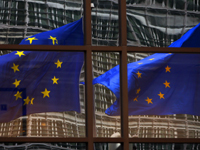IMGXYZ1149IMGZYXNew European Union members are having a mixed influence on European democracy assistance policies and instruments. They have little role in the reform of the European Initiative for Democracy and Human Rights, but an instrumental one in the creation of the European Partnership for Democracy. Their recent experience with democratic transitions has led them to adopt approaches to democracy assistance that are distinct from old EU members.
In a talk moderated by Carnegie's Thomas Carothers, Jacek Kucharczyk, Jeff Lovitt, and Olga Shumylo—authors of Democracy's New Champions. European Democracy Assistance after EU Enlargement—discussed these trends, as well as prospects for the emergence of a European Consensus on Democracy, a framework for what the EU means by democracy and how it should best work to promote it.
Reform of the EIDHR
Lovitt began with a review of the history of the European Initiative (now Instrument) for Democracy and Human Rights (EIDHR), the primary financial instrument the EU uses to promote democracy and human rights worldwide. In 2006 the EIDHR was changed to facilitate the implementation of assistance programs, such as relaxing standards on who can receive assistance. New member states had little voice in this process. After three years, most of the original funding has not been released due to bureaucratic inertia within the EU, making it difficult to assess the impact of the reforms.
European Partnership for Democracy
Kucharczyk pointed to the European Partnership for Democracy (EPD), created in April 2008, as an example of how new EU members are influencing the democracy assistance issue in Europe. Originally envisioned as a European version of the National Endowment for Democracy, the EPD is an independent organization that serves as a knowledge, advocacy, and funding center to complement official EU democracy policy. While a centerpiece of the original idea—that it would receive direct funding from the European Commission—was dropped because of resistance by various European political foundations, it still represents a significant achievement for European democracy support.
Approaches to Democracy Assistance by New EU Members
Lovitt identified some of the distinct features of the democracy assistance sponsored by the new member states. Because of their recent experience with democratic transitions, these states tend to be more idealistic than old EU members and attach greater importance to supporting civil society. They are less opposed to U.S. democracy policy because they have received significant U.S. support in the past. However, they vary in how they structure their assistance agencies, the level of funding provided to democracy assistance, and the geographic scope of their assistance.
In terms of project implementation, Lovitt said that the new members face several similar challenges. Projects are often too small, embassies are understaffed, and the process is slow because project management is centralized in the national capital. As a result, non-governmental organizations have become important players on the ground. State diplomats and consultants, however, remain effective because of their first-hand familiarity with recent democratic transitions in their own countries.
Ukraine: EU versus New Member Democracy Assistance
Shumylo compared EU democracy assistance overall and bilateral democracy assistance from the Visegrad countries to Ukraine. EU assistance suffers from two problems: significant delays in funding, and insufficient levels of funding. Visegrad assistance, particularly peer pressure by their governments and NGO communities, has been more effective. Echoing Lovitt’s comments, she did qualify that procedures for funding at the embassy level are often complicated, coordination between Visegrad countries has been lacking, and too little assistance has been directed to the grass roots level.
European Consensus on Democracy
Lovitt concluded by discussing the prospects for the creation of a European Consensus on Democracy. Two camps within the EU currently exist: those states which prioritize development, and those which prioritize human rights and democracy. There are indications of an emergent agreement to pursue a cross pillar approach emphasizing both. But member states still disagree over other policy issues, such as conditionality versus a “poverty first” approach.
Lovitt stressed that to be effective the Consensus must do several things: include an agreement to reward countries if they move towards greater democracy or good governance; define a modus operandi for how democracy and development policy can work in concert; explicitly place democracy as a goal of a common foreign and security policy if the Lisbon Treaty is passed; and ensure that the delegations in the countries receiving assistance have the mandate and experience to work on democracy. Kucharczyk added that the Consensus will also have to address whether EU democracy policy will prioritize assistance to Eastern Europe, Central Asia and Russia, or if it will focus on the South.
Question & Answers
In the question and answer session, the speakers addressed future reforms of the EIDHR, EU policy towards Belarus and Cuba, political foundation opposition to the EPD, lessons learned from democracy assistance to Ukraine, and how EU democracy policy should be reformed.
